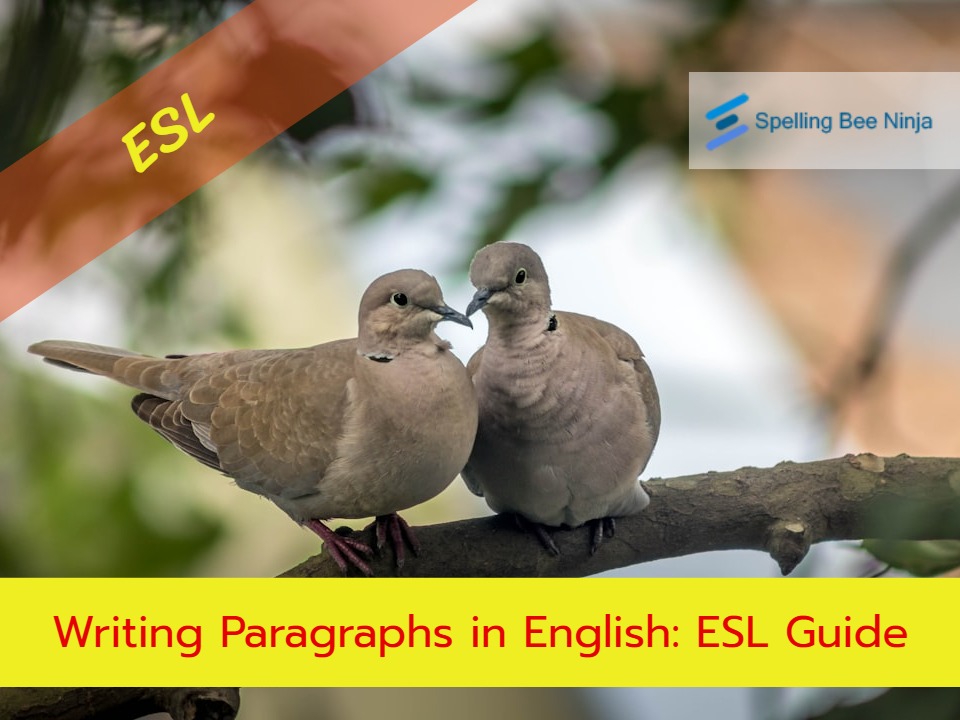Introduction
For learners of English as a Second Language (ESL), writing can feel challenging. Many students focus on grammar, vocabulary, or spelling, but often overlook one of the most important skills: learning how to write clear, well-structured paragraphs. Paragraph writing is the foundation of essays, reports, emails, and almost every kind of written communication. Without solid paragraphs, even good ideas can feel confusing or incomplete. This guide will show ESL learners how to write effective paragraphs step by step, while offering practical examples and tips.
What Is a Paragraph?
A paragraph is a group of related sentences that focus on one main idea. Think of a paragraph as a small “building block” of writing. Each one should be unified, coherent, and complete. A typical paragraph in English is usually 5–8 sentences long, though the exact length can vary depending on the purpose and style of writing. What matters most is not the length but the clarity and unity of the paragraph.
The Three Parts of a Paragraph
Every good paragraph has three essential parts:
Topic Sentence
The topic sentence is usually the first sentence of the paragraph. It introduces the main idea. For example:
“Learning to write strong paragraphs is essential for success in English.”
This sentence tells the reader what the rest of the paragraph will discuss.Supporting Sentences
These sentences explain, expand, or give examples to support the topic sentence. They are the “evidence” that proves the main idea. For example:
“A clear paragraph helps the reader understand your opinion, follow your argument, and see the connections between ideas.”Concluding Sentence
This sentence wraps up the paragraph. It often restates the main idea in a new way or provides a transition to the next paragraph. Example:
“For these reasons, learning paragraph structure is one of the first steps for ESL writers.”
Writing a Topic Sentence
The topic sentence is the most important part of a paragraph. A weak topic sentence can confuse the reader. To write a strong one:
Be clear and direct.
State only one main idea.
Avoid including too many details.
Bad example: “Paragraphs are important and sometimes hard, and you need to practice, and there are many types.”
Better example: “Paragraphs help organize ideas in writing and make texts easier to read.”
Supporting Sentences and Details
After the topic sentence, you need to add supporting sentences. These sentences can:
Give examples: “For instance, in an essay, each body paragraph focuses on a single point.”
Provide reasons: “Paragraphs make texts more organized and less confusing.”
Offer evidence: “Teachers often grade writing based on how clear and unified the paragraphs are.”
A good rule: at least 2–3 supporting sentences are needed to make a paragraph complete.
The Concluding Sentence
A concluding sentence signals that the paragraph is finished. It should not add brand new information but instead summarize the main point. Example:
“Therefore, a strong concluding sentence ensures the reader remembers the central idea.”
Some ESL learners skip the conclusion, but doing so can make writing feel unfinished. Practicing this step helps create smoother, more professional paragraphs.
Coherence and Unity
Two important qualities of a good paragraph are coherence and unity.
Unity means that all sentences in the paragraph are about the same main idea. If one sentence is off-topic, the paragraph feels broken.
Coherence means that sentences connect logically. Using transition words helps create coherence, such as first, however, therefore, in addition, finally.
Example of poor coherence:
“Paragraphs are important. Many students play soccer. Teachers give homework.”
These sentences are not connected.
Better coherence:
“Paragraphs are important because they make writing clear. In addition, they help the reader follow the writer’s ideas. Finally, paragraphs show where one idea ends and another begins.”
Types of Paragraphs in English Writing
ESL students should also understand that paragraphs can have different purposes:
Narrative Paragraphs – tell a story or describe events in order.
Descriptive Paragraphs – describe a person, place, or thing with details.
Expository Paragraphs – explain a fact, idea, or process.
Persuasive Paragraphs – try to convince the reader of an opinion.
Understanding these types helps students adapt their writing for different contexts, such as school essays, work emails, or creative stories.
Common Mistakes ESL Learners Make
Writing topic sentences that are too broad or too vague.
Mixing too many ideas in one paragraph.
Forgetting transitions, which makes writing sound disconnected.
Writing overly short paragraphs with only 1–2 sentences.
Translating directly from the first language, which can result in unnatural sentence order.
By being aware of these pitfalls, learners can improve faster.
Practical Tips for ESL Students
Plan first: Write your topic sentence and 2–3 supporting ideas before writing the full paragraph.
Use transition words: These guide the reader and create flow.
Read aloud: Reading your paragraph out loud helps check coherence.
Study models: Look at well-written English paragraphs and analyze their structure.
Practice daily: Even short daily writing practice (like keeping a journal) strengthens skills.
Example Paragraph (Expository)
“Learning English grammar is important, but writing good paragraphs is equally necessary. A paragraph allows a writer to express one idea clearly and logically. It also helps the reader follow the text more easily. Without paragraphs, writing becomes confusing and difficult to read. For this reason, every ESL student should practice writing structured paragraphs.”
This model shows topic sentence, supporting details, and a conclusion—all in a simple, effective form.
Practice Exercises: Writing Paragraphs in English
Exercise 1: Identify the Topic Sentence
Read the sentences below. Which one should be the topic sentence? Which are supporting details?
For example, students who write daily journals often see improvement within a few months.
Regular practice helps ESL learners write better paragraphs.
This is because practice builds confidence and fluency.
Answer: Sentence 2 is the topic sentence. Sentences 1 and 3 are supporting details.
Exercise 2: Fix the Weak Topic Sentence
The following topic sentence is too broad:
“There are many things in the world.”
Rewrite it to make it specific and suitable for a paragraph.
Possible answer: “Reading books in English is one of the best ways for ESL learners to improve vocabulary.”
Exercise 3: Organize the Sentences
Put these sentences in a logical order to form a paragraph:
A good night’s sleep improves memory and concentration.
For these reasons, students should not ignore their sleep schedule.
Sleep is important for students who want to succeed in school.
Without rest, the brain cannot perform at its best.
Correct order: (3) Topic sentence → (1) Supporting → (4) Supporting → (2) Conclusion.
Exercise 4: Add a Concluding Sentence
Read the short paragraph:
“Many students use dictionaries when writing in English. Dictionaries help learners find the correct spelling of words. They also show the different meanings a word can have.”
Now write a concluding sentence to complete the paragraph.
Example: “Therefore, dictionaries are essential tools for ESL learners.”
Exercise 5: Write Your Own Paragraph
Choose one of the topics below and write a paragraph of 5–7 sentences. Remember to include:
A topic sentence
At least 3 supporting details
A concluding sentence
Topics to choose from:
Why learning English is important today.
A hobby you enjoy and why.
The benefits of learning with friends.
Your favorite place and its special features.
Answers
Exercise 1: Identify the Topic Sentence
Correct topic sentence: 2. Regular practice helps ESL learners write better paragraphs.
Supporting details: 1 and 3.
Exercise 2: Fix the Weak Topic Sentence
Original: “There are many things in the world.”
Possible improved answers (students’ answers may vary, but should be focused):
“Reading books in English is one of the best ways for ESL learners to improve vocabulary.”
“Learning to write paragraphs is an important skill for English learners.”
“Healthy food is important for students who want to succeed in school.”
Exercise 3: Organize the Sentences
Correct order:
Sleep is important for students who want to succeed in school. (topic sentence)
A good night’s sleep improves memory and concentration. (supporting detail)
Without rest, the brain cannot perform at its best. (supporting detail)
For these reasons, students should not ignore their sleep schedule. (conclusion)
Exercise 4: Add a Concluding Sentence
Student answers may vary. Correct answers should summarize or close the idea.
Example: “Therefore, dictionaries are essential tools for ESL learners.”
Other good answers:
“For this reason, every student should learn how to use a dictionary.”
“In conclusion, dictionaries can help students become independent learners.”
Exercise 5: Write Your Own Paragraph
Students’ responses will vary. Here are some sample paragraphs for each topic:
Topic 1: Why learning English is important today
“Learning English is very important in the modern world. It is the language of business and international communication. Many websites, movies, and books are written in English. People who know English can also travel more easily. In conclusion, English is a key skill for success in school and work.”
Topic 2: A hobby you enjoy and why
“My favorite hobby is painting. Painting helps me express my creativity and feelings. It also helps me relax after a long day. Sometimes I give my paintings to friends as gifts, which makes them happy. For these reasons, painting is the hobby I enjoy the most.”
Topic 3: The benefits of learning with friends
“Learning with friends is very helpful. Friends can explain difficult things in a simple way. Studying together also makes learning more fun. In addition, friends can encourage each other to keep working hard. Therefore, learning with friends is a good way to study.”
Topic 4: Your favorite place and its special features
“My favorite place is the beach. I like the sound of the waves and the fresh air. The beach is also a good place for exercise, like swimming and walking. When I visit, I feel peaceful and happy. For these reasons, the beach is my favorite place.”
Conclusion
Writing paragraphs in English may seem difficult at first, but it becomes easier with practice. By learning to create strong topic sentences, supporting details, and clear conclusions, ESL learners can improve not only their academic writing but also their everyday communication. Paragraphs are the foundation of all longer texts, from essays to stories to reports. Once you master them, you will have a powerful tool to express your thoughts, opinions, and knowledge in English. Remember, every essay is just a collection of paragraphs, and every paragraph is a chance to share one focused idea with the world. With patience, practice, and attention to structure, any ESL learner can become a confident and effective writer.
- Essay Writing for Beginners: A Step-by-Step Guide with Examples
- ✈️ How to Write an Email Like a Pro: Tips for Effective Communication
- ✈️ How to write a letter in English
- 🧩 Rules for Writing Numbers – How to Write Numbers in Words
- ✈️ How To Write a CV – The 10 Golden Rules
- 5 Most Important Spelling Rules to Improve Your Writing Skills
- 🐝 Prepositions words list – What you need to know
- ✈️ Writing Paragraphs in English: ESL Guide


